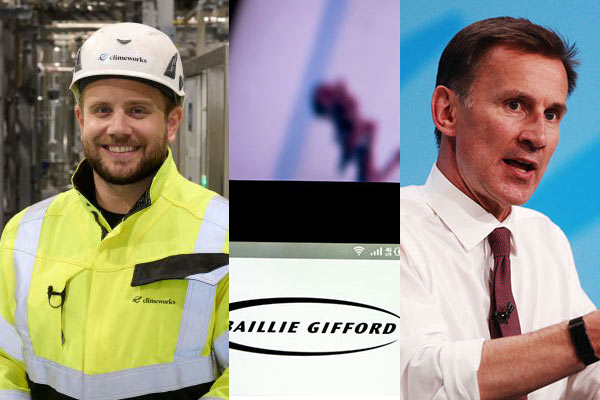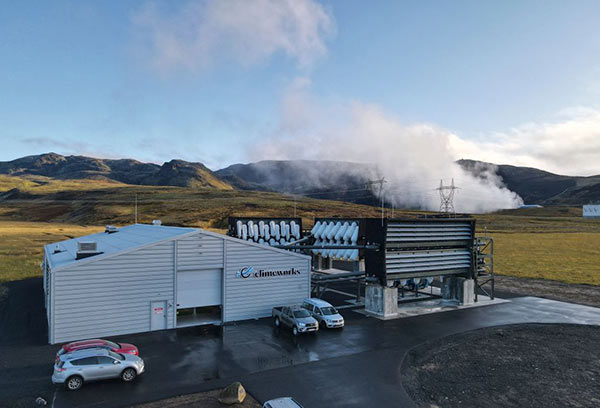Decarbonisation: shares, funds and trusts for the race to net zero
18th April 2023 12:28
by Nina Kelly from interactive investor
Accelerate climate change targets, warns the UN, while Jeremy Hunt unveils investment in carbon capture, and Scottish Mortgage backs a pioneer.

Iceland, home to Björk, the Blue Lagoon, and giant machines sucking carbon dioxide out of the air. Swiss firm Climeworks, which counts growth investor Baillie Gifford as a backer, opened Orca, its first large-scale carbon capture plant, in Iceland in 2021. A second, Mammoth, is being built and is due to open next year. When fully operational, the plant’s capture capacity will be up to 36,000 tons of carbon dioxide annually.
On Baillie Gifford’s website, it explains that Climeworks’ “direct air capture technology works by using renewable energy to power big fans, which blow air across a solid ‘sorbent’ filter that binds with carbon dioxide”. Engineers then remove the sorbent - a insoluble material which absorbs liquids or gases - and heat it to release the greenhouse gas, which is then permanently stored in basalt rock formations underground, while the filter is reused.
- Invest with ii: Buy Global Funds | Top Investment Funds | Open a Trading Account
Last year, Baillie Gifford invested in Climeworks, which raised the largest-ever direct air capture investment, equivalent to $650 million (£529 million), according to the International Energy Agency (IEA). The private firm is among Scottish Mortgage (LSE:SMT)’s holdings, according to its latest report dated 28 February. Scottish Mortgage, an investment trust for adventurous investors owing to its bias to high-growth stocks, considers ‘decarbonisation’ to be one of four ‘strands’ in its portfolio. Other stocks under the decarbonisation banner include electric vehicle manufacturer Tesla (NASDAQ:TSLA), drone delivery firm Zipline, and Swedish lithium battery producer Northvolt.
Climeworks has partnered with many firms “on their journey to net zero”, including Microsoft, Ocado, UBS, Stripe,and Shopify. This week, Climeworks confirmed plans to scale up in the United States. Listed firms operating in the carbon capture space include fuel cell manufacturer FuelCell Energy (NASDAQ:FCEL), which is headquartered in Connecticut. According to the $970 million Nasdaq-listed company: “About 35 billion tons of carbon dioxide are emitted globally per year. Our platforms can capture carbon emissions from the exhaust streams of coal or gas-fired power plants, while simultaneously producing clean power.” FuelCell Energy’s share price is down a painful 98% since IPO in 1992. Yet it exceeded $7,000 in 2000, compared with an IPO figure of $216.

A few reasons explain the poor performance. Exiting shareholders often float their business at the best possible valuation and at a level which proves hard to maintain; there’s been a lot of optimism around ‘clean’ energy and hydrogen stocks such as FuelCell, but investors can get impatient if results are slow in coming; and carbon capture, one element of FuelCell's business, is an evolving technology, and one which pessimists might argue makes it a ‘jam tomorrow’ stock.
Small-cap Canadian firm Delta CleanTech Inc (CSE:DELT) is a self-described “technology industry leader in carbon dioxide capture for hydrogen plants”. The C$3.8 million (£2.2 million) company says that it “has developed cost-effective carbon dioxide capture solutions for CO2-enhanced heavy oil production, coal and gas power generation and the industrial food grade CO2 markets”. In terms of performance, Delta CleanTech is similarly beleaguered and down 89% since flotation in 2021.
Growth firms and small caps, such as Delta CleanTech are high-risk options and firmly out of favour right now because of rising interest rates and inflation, which hurt future earning predictions for growing companies. Delta CleanTech is also perceived as a ‘jam tomorrow’ stock, but policy support for hydrogen and carbon capture from governments, including US president Joe Biden’s Inflation Reduction Act, passed in 2022, could revive interest.
According to Time magazine, a “dramatic change in a crucial tax credit for the carbon capture industry — increasing the government subsidy for capturing carbon dioxide from polluting sources from $50 to $85 per metric ton. Developers say boosting that incentive could tip many projects that once weren’t worth the investment over the financial finish line.”
- Should investors be building a new strategy for the next decade?
- Funds and trusts four professionals are buying and selling: Q2 2023
California-based Bloom Energy (NYSE:BE), perhaps best known for its hydrogen fuel cells, is faring better. The $3.8 billion (£3 billion) business also sells carbon capture technology through its solid oxide fuel cells, which generate electricity via an electrochemical reaction. Hydrogen and water from the fuel cell exhaust are captured and the water vapour and carbon dioxide are separated. The carbon dioxide can then be stored in the ground or used in new ways. Bloom’s share price is down 18% since its IPO in 2018, but in February 2021 the stock had almost doubled in price.
The conflict in Ukraine and the resultant energy crises have demoted climate change down the investment agenda, at least in the near term, suggests Dzmitry Lipski, head of funds research at interactive investor. However, the long-term impact of the war could accelerate the energy transition from fossil fuels and increase demand for renewable energy, he adds.
There is growing support for carbon capture. In the Spring Budget, Chancellor of the Exchequer Jeremy Hunt announced £20 billion of investment in carbon capture technology and nuclear power over two decades. In the same month, the United Nations published a climate report and UN secretary-general Antonio Guterres (pictured below) said all countries should bring forward their net-zero plans by a decade. The UK has pledged to achieve net zero by 2050 and to decarbonise its electricity system by 2035. The UN report acknowledged that “large-scale use of carbon dioxide removal technology will be needed”.

When I checked the website of National Grid ESO, which operates Great Britain's electricity system, just days before this year's annual Earth Day event on 22 April, it showed how far there is to go. In the year 2000, fossil fuels generated 70.3% of Britain’s electricity and zero carbon sources just 24.3%. By the end of 2013, zero carbon sources generated 32.8% of our electricity. Five years later it was 43.5%, and by last month, UK electricity provided by zero carbon sources reached 47%. That’s progress, but we’re still not half-way to net zero, and not everyone is blown away by the prospect of carbon capture.
In a BBC article covering the UN’s climate report, Lili Fuhr of the Centre for International Environmental Law said, “the carbon removal part and carbon capture and storage ideas are a massive distraction”. The Guardian reported that Ami McCarthy, Greenpeace UK’s political campaigner, said that: “Squandering taxpayers’ money on nuclear reactors that don’t even exist yet and fanciful carbon capture is irresponsible, and does nothing to reduce our emissions now. Committing to £20 billion over 20 years is frankly pathetic compared to the green growth investments being made in the US, EU, and China.”
The IEA is more sanguine. In a September 2022 report, it said that: “Carbon removal technologies such as DAC (direct air capture) are not an alternative to cutting emissions or an excuse for delayed action, but they can be an important part of the suite of technology options used to achieve climate goals.” There are currently 18 direct air capture plants in Europe, the US and Canada extracting carbon directly from the atmosphere.
While countries chase net zero targets and cut emissions, one issue that may stymie the UK’s progress is a lack of skilled workers. Sam Alvis, head of economy at the think tank and charity Green Alliance, spoke on a BBC Radio 4 programme last month called ‘Costing the Earth: jobs for a green future’. He said: “We need to be thinking about people and skills as one of the most fundamental barriers to achieving both our climate targets, like the net zero pledge by 2050, and our wider environmental ambitions to restore nature.”
- Jeff Prestridge: the best investment thing since sliced bread
- What 120 years of stock market data tells us about where to invest today
His comments were echoed by Amer Gaffa, director of the Fuel Cell Innovation Centre at Manchester Metropolitan University, who said: “When we announce last-scale infrastructure projects, whether they are hydrogen or solar or wind, we need to transform the skills system to be able to cope with it. Infrastructure can be bought. We know we can buy infrastructure if we’ve got the funding to be able to do so. But if we don’t get the ability to run that infrastructure properly with the right skillset, it will never work.”
How big a role carbon capture will play mitigating climate change will depend on its scalability among other factors, but the long-term theme of decarbonisation is here to stay. Here are a handful of ideas for investors to consider.
“Funds with a focus on climate change and environmental, social and governance (ESG) in general have had a tough time over the last year, as many of them are growth-oriented and invest in relatively small, faster-growing companies in sectors such as technology,” says Lipski. He adds that growth as an investment style has ‘really struggled’ because rising interest rates and inflation make investors evaluate how much the future earnings of these companies are worth today. For investors seeking to participate in positive climate change, Lipski suggests checking that portfolios are well diversified and avoid a strong bias to a single style or market cap.
One option he suggests is the iShares Global Clean Energy ETF USD Dist GBP (LSE:INRG), an exchange-trade fund (ETF) which appears in interactive investor’s ACE 40 list of investment ideas. This passive fundtracks the performance of the S&P Global Clean Energy Index of companies in global clean energy-related businesses in both developed and emerging markets. Stocks include FuelCell Energy, discussed above, First Solar (NASDAQ:FSLR), ethanol producer Green Plains (NASDAQ:GPRE), and hydrogen fuel-cell maker Plug Power (NASDAQ:PLUG). The ETF is the best option to gain passive exposure in this space, thinks Lipski, due to its broad, diversified exposure to the clean energy theme, improved underlying liquidity and its proven track record. The fund’s one, three and five-year total return figures are -0.78%, 89.2% and 142.4%.

Another fund that appears in ii’s ACE 40 list is VT Gravis Clean Energy Income. This is for investors seeking stable long-term dividend income, low volatility, capital protection and growth. The fund offers exposure to companies that have significant involvement in the clean energy sector such as wind, solar and hydro. Fund manager Will Argent has run the fund since inception in December 2017. More than half the portfolio is invested in the UK. Among its top 10 holdings are Greencoat UK Wind (LSE:UKW), the Renewables Infrastructure Group (LSE:TRIG) and renewable energy company Clearway Energy (NYSE:CWEN). The current yield is over 4%. The fund’s one, three and five-year total return figures (to 17 April) are -2.5%, 40.1% and 93.3%.
Lipski’s final suggestion is the Climate Assets Balanced Fund, which aims to deliver long-term growth and income. Claudia Quiroz has managed the fund, also an ACE 40 option, since 2010 and focuses on businesses involved in providing solutions to challenges including climate change. Top 10 holdings, according to the March 2023 factsheet, include public railroad Union Pacific (NYSE:UNP). The investment team atClimate Assets says:“While the transportation sector as a whole is one of the largest contributors to greenhouse gas emissions, railway transportation accounts for only a fraction of these emissions…and is less carbon-intensive than freight by road or air.” Other firms in the top 10 include global supplier of electrical equipment Schneider Electric (XETRA:SND), which produces electric vehicle charging ports, and waste disposal and recycling services firm Waste Management (NYSE:WM).
Equity exposure is currently 64%, bonds 17%, and alternatives 11%. Climate Assetsis suitable for investors who have a balanced risk appetite and are seeking to invest in the growth markets of sustainability and environmental technologies, but with lower volatility of returns. The fund’s one, three and five-year total return figures (to 17 April) are -0.4%, 20.5%, and 36.8%.
- ‘High risk? I don’t see it that way’: the investment secrets of an ISA millionaire
- Day in the life of a fund manager: Vanguard's Mohneet Dhir
Other ideas include Ninety One Global Environment, a high-conviction play with just 23 stocks in its portfolio. The fund “invests primarily (at least two-thirds and typically substantially more) in the shares of firms which the manager believes contribute to positive environmental change through sustainable decarbonisation (the process of reducing carbon dioxide emissions)”. Top holdings include electrical connector supplier TE Connectivity (NYSE:TEL), engineering software company Ansys (NASDAQ:ANSS), and utilities firm Iberdrola (XMAD:IBE). The fund’s one, three and five-year total return figures (to 17 April) are 9.6%, 68.9%, and 77.1%.
Another option is the thematic HAN iClima Global Decarbonisation Enablers ETF (LSE:CLMA), whichhas an ongoing charges figure (OCF) of 0.65%. One criterion for inclusion is that companies must“operate in the following five sectors that enable CO2 avoidance: green energy; green transportation; water and waste improvements; decarbonisation enabling solutions; and sustainable products”.Among its top 10 are Tesla, ride-sharing stock Uber (NYSE:UBER), and Verbund (XETRA:OEWA), one of Europe's largest generators of electricity from hydropower. Outside the top 10 are offshore wind play Orsted and two firms discussed above,Bloom Energy and FuelCell Energy. This ETF was established in 2020, so only its one-year return (-5.5%) figure is available.
These articles are provided for information purposes only. Occasionally, an opinion about whether to buy or sell a specific investment may be provided by third parties. The content is not intended to be a personal recommendation to buy or sell any financial instrument or product, or to adopt any investment strategy as it is not provided based on an assessment of your investing knowledge and experience, your financial situation or your investment objectives. The value of your investments, and the income derived from them, may go down as well as up. You may not get back all the money that you invest. The investments referred to in this article may not be suitable for all investors, and if in doubt, an investor should seek advice from a qualified investment adviser.
Full performance can be found on the company or index summary page on the interactive investor website. Simply click on the company's or index name highlighted in the article.